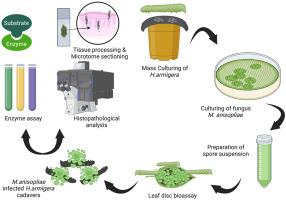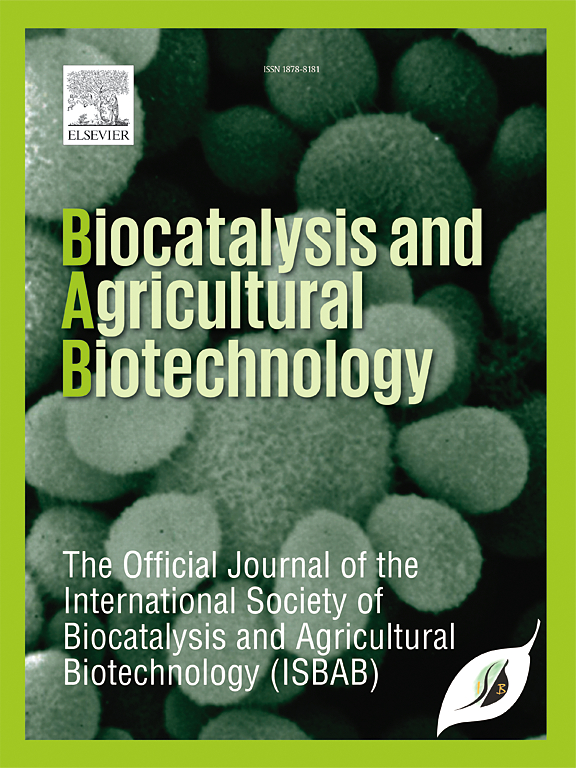绿僵菌对棉铃虫组织化学和酶活性的影响(h bner, 1809)
IF 3.4
Q2 BIOTECHNOLOGY & APPLIED MICROBIOLOGY
引用次数: 0
摘要
绿僵菌具有多种作用机制和对不同田间条件的适应性,是一种广泛应用于农业的生物防治剂。然而,靶虫的免疫应答对绿僵菌对害虫的毒力有显著影响。在这些害虫中,番茄果螟,Helicoverpa armigera,作为一种多食性和经济上重要的物种,因其对许多杀虫剂具有抗性而脱颖而出。因此,了解绿僵菌与棉蚜免疫防御之间的相互作用对于制定有效的生物防治策略至关重要。在实验室条件下,采用叶片浸渍法测定了5株绿僵菌对2龄和4龄棉铃虫的抗性。分离物ICAR SBI Ma 08对两种菌种均最有效,LC50最低(2.56 × 106;3.56 × 108)和LT50值(4.36和6.36天)。其他菌株的药效顺序为ICAR SBI Ma 01 >;ICAR SBI Ma 69 >;ICAR SBI Ma 04 >;ICAR SBI Ma 172。该分离物通过抑制酯酶、混合功能氧化酶、乙酰胆碱酯酶和多酚氧化酶等解毒酶的活性,有效规避了棉铃虫的免疫应答。相反,在感染这种强效菌株后,幼虫表现出谷胱甘肽s转移酶、过氧化氢酶、芳基酰基酰胺酶和过氧化物酶的活性增加。孢子浓度的增加对绿僵菌的致病性有正向影响。组织病理学研究表明,ICAR SBI Ma 08成功地突破了第一表皮层,菌丝在感染后24 h内到达了原质系统。M. anisopliae ICAR SBI Ma 08在LT50降低的情况下对二龄虫的杀灭效果最好,表明该菌株具有调节酶活性,可以有效地利用该菌株对一龄和二龄虫进行杀灭。开发一种适当的制剂并确定其田间药效将证实ICAR SBI Ma08作为真菌杀虫剂的潜力。本文章由计算机程序翻译,如有差异,请以英文原文为准。

Effects of Metarhizium anisopliae on the histochemistry and enzymatic activities of Helicoverpa armigera (Hübner, 1809)
Metarhizium anisopliae, is widely utilized as a biocontrol agent in agriculture due to its diverse mechanisms of action and adaptability to various field conditions. However, the immune responses of the target insects significantly influence M. anisopliae virulence against insect pests. Among these pests, the tomato fruit borer, Helicoverpa armigera, stands out as a polyphagous and economically significant species for its resistance to numerous insecticides. Understanding the interaction between M. anisopliae and H. armigera immune defense is therefore critical for developing effective biocontrol strategies. In this study, five isolates of M. anisopliae were evaluated against the second and fourth instars of H. armigera using leaf dip-bioassay under controlled laboratory conditions. The isolate ICAR SBI Ma 08 was the most effective against both instars, with lowest LC50 (2.56 × 106 & 3.56 × 108) and LT50 values (4.36 and 6.36 days). The order of efficacy of other strains was ICAR SBI Ma 01 > ICAR SBI Ma 69 > ICAR SBI Ma 04 > ICAR SBI Ma 172. This isolate effectively evaded the immune response of H. armigera by inhibiting the activities of detoxifying enzymes such as esterase, mixed-function oxidase, acetylcholinesterase, and polyphenol oxidase. Conversely, following infection with this potent strain, larvae exhibited increased activities of glutathione S-transferase, catalase, aryl-acylamidase, and peroxidase. An increase in spore concentration had a positive impact on M. anisopliae pathogenicity. Histopathological studies showed that ICAR SBI Ma 08 successfully breached the first epidermal layer, with mycelia reaching the promeristem within 24 h post-infection. M. anisopliae ICAR SBI Ma 08 exhibited the highest efficacy against the second instar with a reduced LT50, and its modulating enzymatic activity suggested that this isolate could be effectively deployed against the first and second instars of H. armigera. Developing an appropriate formulation and ascertaining its efficacy at the field level will confirm ICAR SBI Ma08's potential as a mycoinsecticide.
求助全文
通过发布文献求助,成功后即可免费获取论文全文。
去求助
来源期刊

Biocatalysis and agricultural biotechnology
Agricultural and Biological Sciences-Agronomy and Crop Science
CiteScore
7.70
自引率
2.50%
发文量
308
审稿时长
48 days
期刊介绍:
Biocatalysis and Agricultural Biotechnology is the official journal of the International Society of Biocatalysis and Agricultural Biotechnology (ISBAB). The journal publishes high quality articles especially in the science and technology of biocatalysis, bioprocesses, agricultural biotechnology, biomedical biotechnology, and, if appropriate, from other related areas of biotechnology. The journal will publish peer-reviewed basic and applied research papers, authoritative reviews, and feature articles. The scope of the journal encompasses the research, industrial, and commercial aspects of biotechnology, including the areas of: biocatalysis; bioprocesses; food and agriculture; genetic engineering; molecular biology; healthcare and pharmaceuticals; biofuels; genomics; nanotechnology; environment and biodiversity; and bioremediation.
 求助内容:
求助内容: 应助结果提醒方式:
应助结果提醒方式:


